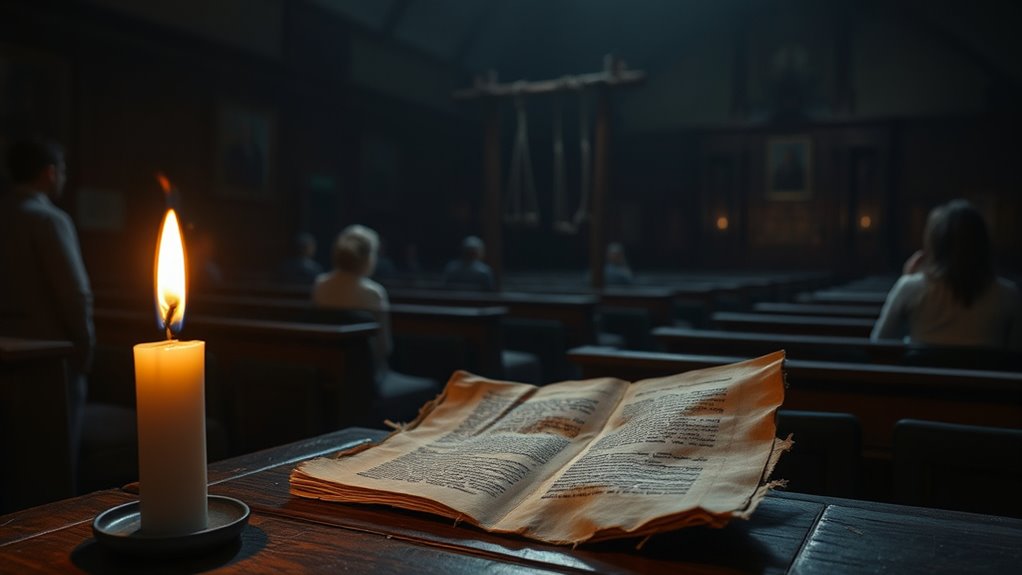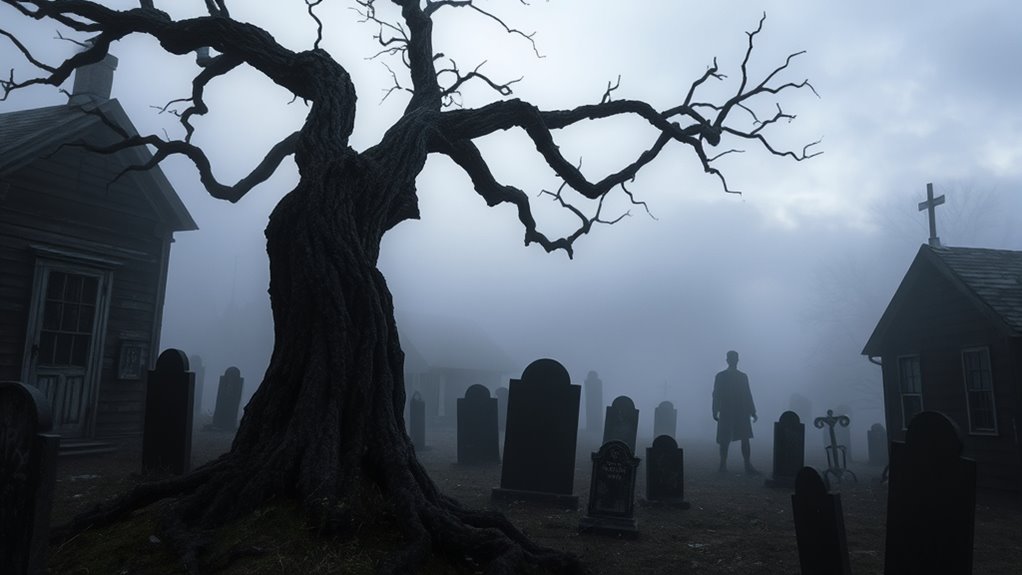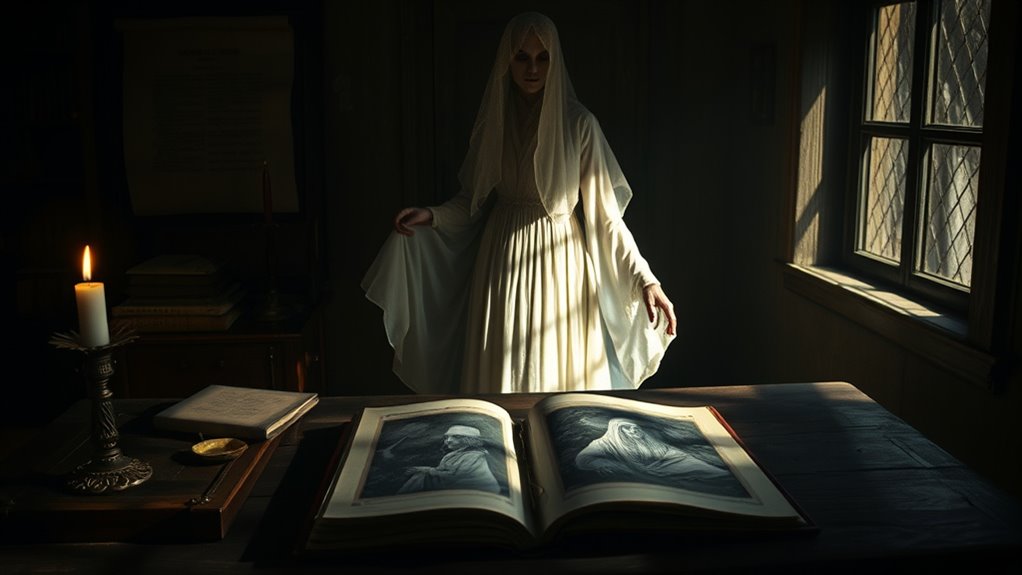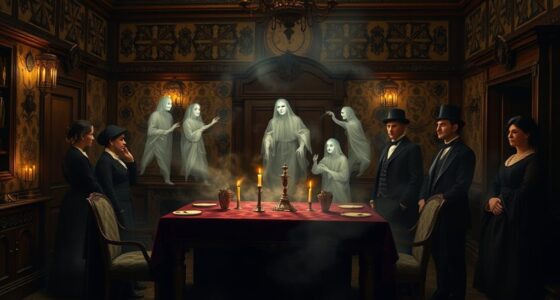The Salem Witch Trials are often misrepresented, with many believing there were mass burnings at the stake. In truth, only 20 were hanged, and the trials were overshadowed by war trauma, political instability, and intense family rivalries. Women made up the majority of the accused, revealing deep-rooted misogyny. The trials were brief, ending in early 1693, but their effects lingered for centuries. If you explore further, you’ll uncover the intricacies behind this tragic history.
Key Takeaways
- The Salem Witch Trials did not involve burning at the stake; most accused were hanged, with one man pressed to death.
- Accusations were driven by local rivalries and post-war trauma, creating an environment of distrust among Puritans.
- Misogyny played a significant role, as women comprised 75-80% of the accused, often targeting the elderly.
- The trials lasted from late summer 1692 to early spring 1693, ending after Governor Phipps intervened.
- An official apology for the trials was issued in 1957, yet the aftermath led to a long silence in Massachusetts.
Debunking the Myths of Witchcraft Executions

While many people believe the Salem Witch Trials were marked by widespread executions of witches, the reality is quite different. In Salem, none of the accused faced burning at the stake; instead, 20 individuals were hanged, and Giles Corey was pressed to death for refusing to plead.
This misconception about witch hunts is rooted in a distorted view of history. Unlike other trials, Salem lacked trained judges and proper legal representation, leading to unjust outcomes for innocent people.
Additionally, practices like float tests weren’t used; those accused underwent tests like reciting the Lord’s Prayer.
It’s worth noting that about 75-80% of those accused were women, reflecting societal biases rather than any true association with witchcraft.
The Complex Causes of Salem Hysteria

The Salem hysteria didn’t arise in a vacuum; it was fueled by a tangled mix of war trauma, political instability, and simmering family feuds.
You can see how these factors intertwined, creating an environment ripe for accusations of witchcraft.
- Trauma from King Philip’s War left deep scars on the community.
- Political instability heightened the Puritans’ vulnerability and suspicion.
- Intense family rivalries, especially between the Putnams and Porters, fueled distrust.
- The majority of accusations came from the west end of Salem Village, targeting those in the east.
This dynamic illustrates how Salem hysteria wasn’t merely about superstition; it reflected deeper community conflicts, showcasing the impact of trauma and rivalries on the trials.
Gender Dynamics in Accusations

Accusations during the Salem Witch Trials reveal a striking gender imbalance, with women comprising about 75-80% of those targeted. Misogyny fueled these accusations, as male theologians believed women were more susceptible to witchcraft. While the majority of accused were female, around 20-25% were men, illustrating that not all victims were women.
| Gender | Percentage Accused |
|---|---|
| Female | 75-80% |
| Male | 20-25% |
| Executed | Majority Female |
The typical profile of an accused witch often included elderly women, with nine of fourteen hanged being over 55. This gender dynamic illustrates how societal perceptions contributed to the hysteria that led to countless innocent people being executed.
The Duration and Conclusion of the Trials

Although the Salem Witch Trials unfolded rapidly, they stretched from late summer 1692 to early spring 1693, lasting roughly six months.
During this turbulent period, you’d find that the hysteria in Salem led to:
- Twenty people executed for witchcraft, primarily by hanging
- A few individuals burned at the stake, although this was less common
- The Court of Oyer and Terminer overseeing the trials
- Governor William Phipps eventually halting the proceedings
Ultimately, after his wife was accused, Phipps intervened, leading to the suspension of the court’s operations.
Accusations ceased, and sentences for the accused were commuted, marking a significant conclusion to this dark chapter in Massachusetts Bay’s history, as noted by many a history professor.
The Aftermath and Modern Perception of the Trials

In the wake of the Salem Witch Trials, a heavy silence blanketed Massachusetts for over 250 years, leaving victims’ families without justice. Misconceptions about the Salem trials persist today; many mistakenly believe witches were burned, when in fact, most were hanged. The aftermath of the Salem Witch Trials left a legacy that informs discussions on justice and societal fears in American history. An official apology didn’t come until 1957, highlighting the lack of accountability for the accused witches. Modern Salem embraces its heritage with festivals and shops, attracting tourists each October, yet this commercialization sparks mixed feelings among residents.
| Past Events | Modern Perceptions |
|---|---|
| No justice for victims | Festivals celebrating history |
| Silence for 250 years | Mixed feelings about commercialization |
| Official apology in 1957 | Tourism boosts local economy |
| Misconceptions persist | Education on historical facts |
| Puritans’ fears linger | Discussions on social justice |
Frequently Asked Questions
What Are 3 Facts About the Salem Witch Trials?
You might find it interesting that the Salem Witch Trials saw over 200 people accused of witchcraft, with 20 executed, mostly by hanging.
Most of the accused were women, but around 20-25% were men.
The hysteria was fueled by social tensions and trauma from previous wars, leading to a breakdown of legal procedures, as judges lacked legal training and defense attorneys were absent for the accused.
It’s a fascinating yet tragic part of history.
How Accurate Is the Salem Witch Trials Movie?
Watching a Salem Witch Trials movie can feel like reading a thrilling novel filled with twists and turns.
However, you’ll find that many films take liberties with historical accuracy. They often depict witches being burned at the stake, which never happened in Salem. They exaggerate float tests and ignore the complex socio-political tensions behind the hysteria.
Were the Salem Witch Trials Innocent Until Proven Guilty?
No, the Salem Witch Trials didn’t follow the principle of “innocent until proven guilty.”
Instead, accusations often relied on unreliable evidence, like dreams and personal testimonies. You’d find that judges accepted this dubious evidence, leading to wrongful convictions.
The lack of fair legal processes meant that many were condemned without solid proof.
It wasn’t until later that a shift occurred, emphasizing the need for substantial evidence and protecting the rights of the accused.
What Was the Real Reason for the Salem Witch Trials?
Have you ever wondered what really sparked the Salem Witch Trials? The trials arose from a mix of personal rivalries, community tensions, and a backdrop of war trauma.
As fear gripped Salem, accusations often stemmed from longstanding feuds, particularly involving the Putnam family. Political instability and a rigid Puritan belief system further fueled paranoia, leading people to accept dubious evidence.
Ultimately, a toxic blend of anxiety and distrust ignited this tragic chapter in history.
Conclusion
As you reflect on the Salem witch trials, the chilling reality becomes clear: what we thought we knew is only the surface of a dark, tangled web of fear and manipulation. The echoes of those accusations still linger, reminding us of the dangers of hysteria and scapegoating. What if a similar panic were to unfold today? The lessons of Salem urge you to question, to dig deeper, and to guarantee history doesn’t repeat itself in insidious ways.









